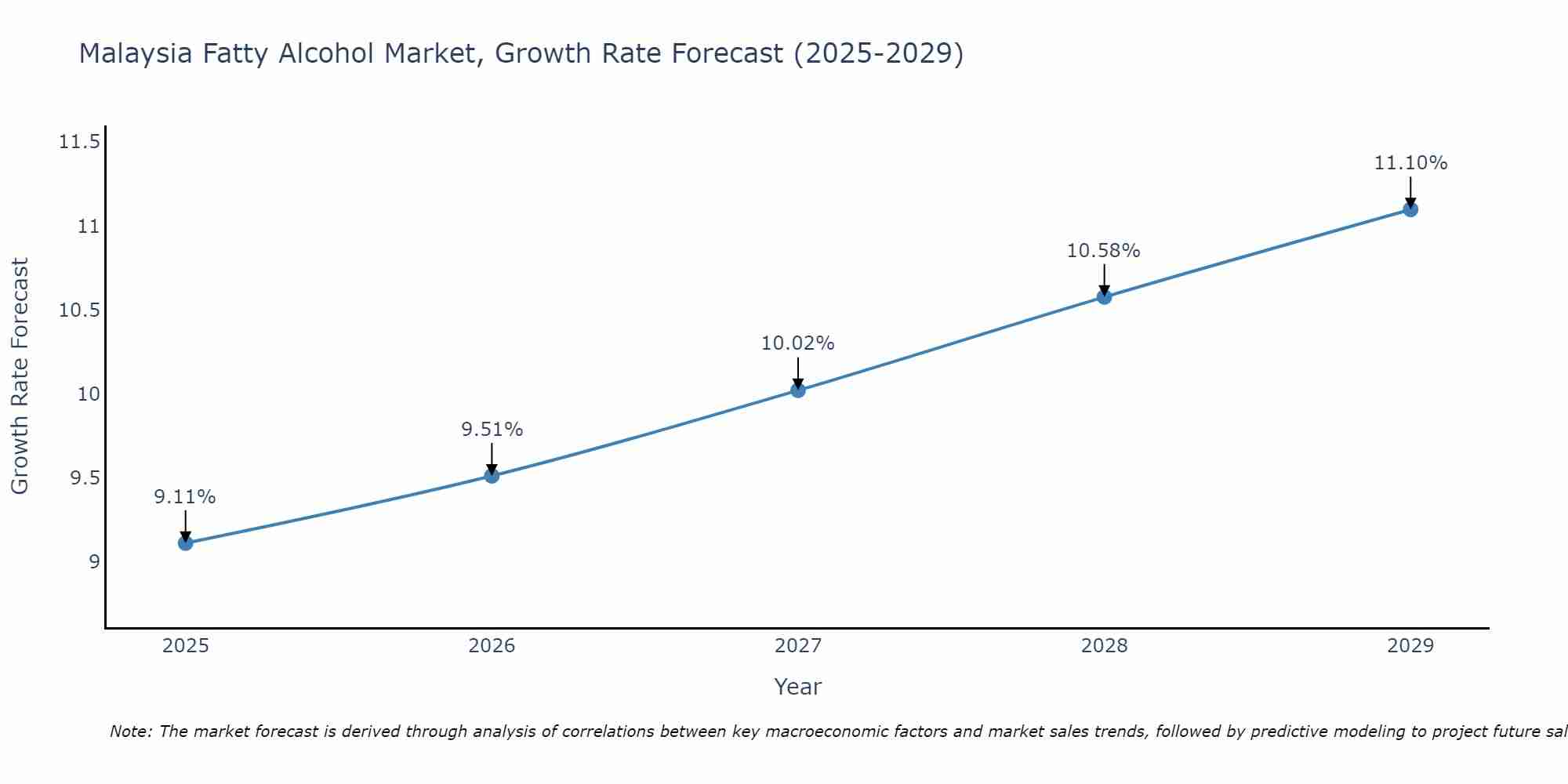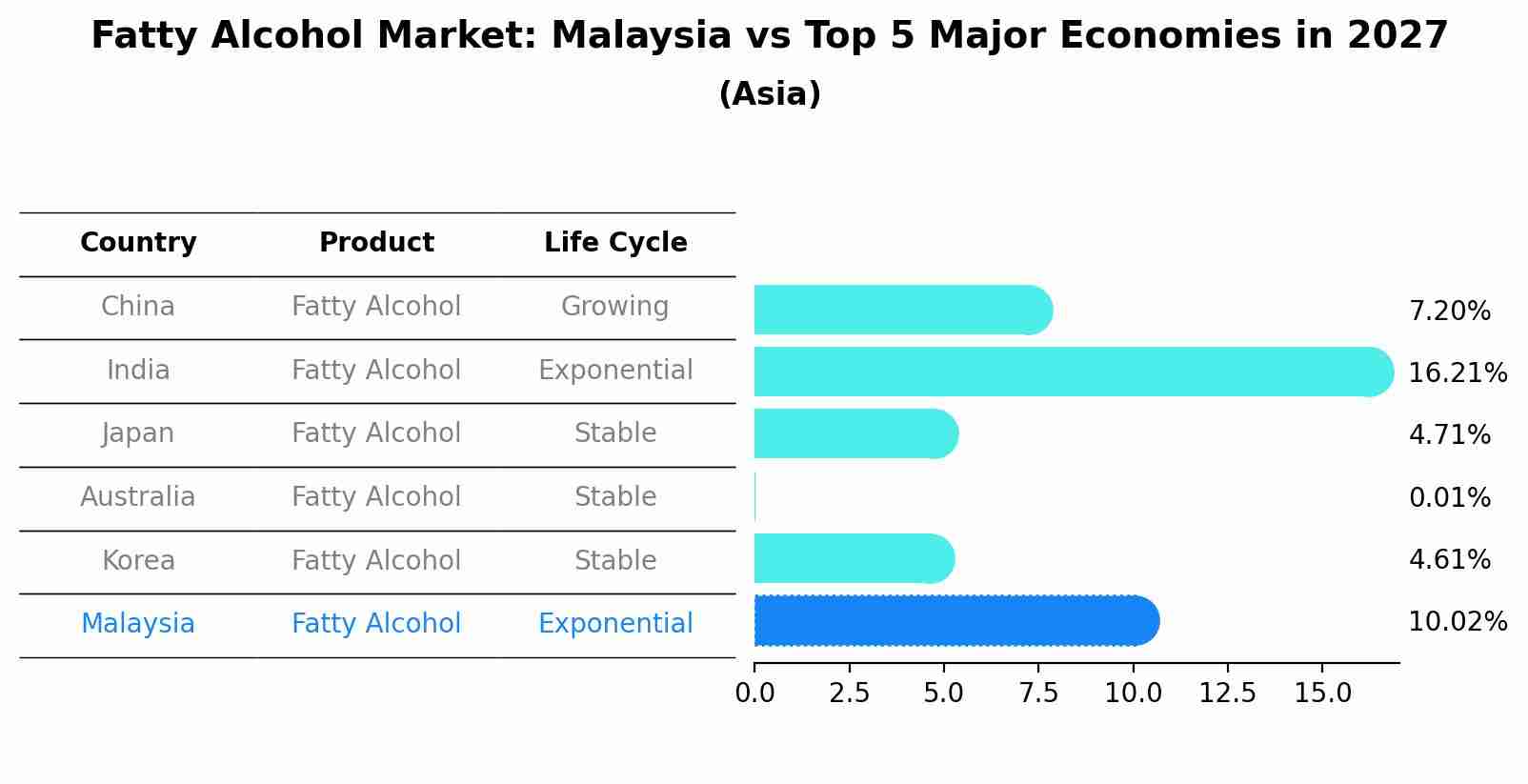Malaysia Fatty Alcohol Market (2025-2031) Outlook | Companies, Share, Value, Industry, Revenue, Size, Growth, Trends, Forecast & Analysis
| Product Code: ETC324686 | Publication Date: Aug 2022 | Updated Date: Aug 2025 | Product Type: Market Research Report | |
| Publisher: 6Wresearch | Author: Ravi Bhandari | No. of Pages: 75 | No. of Figures: 35 | No. of Tables: 20 |
Malaysia Fatty Alcohol Market Size Growth Rate
The Malaysia Fatty Alcohol Market is likely to experience consistent growth rate gains over the period 2025 to 2029. Commencing at 9.11% in 2025, growth builds up to 11.10% by 2029.

Fatty Alcohol Market: Malaysia vs Top 5 Major Economies in 2027 (Asia)
Malaysia's Fatty Alcohol market is anticipated to experience a high growth rate of 10.02% by 2027, reflecting trends observed in the largest economy China, followed by India, Japan, Australia and South Korea.

Malaysia Fatty Alcohol Market Synopsis
Fatty alcohols are used in numerous industries, including personal care, pharmaceuticals, and chemicals. Malaysia is a key player in the production of fatty alcohols, mainly derived from palm oil. The market outlook depends on global demand for these versatile compounds, influenced by factors like sustainability, industrial growth, and regulatory changes affecting raw materials and end-use applications.
Drivers of the Market
The Malaysia fatty alcohol market is experiencing growth due to its versatile applications in industries such as personal care, pharmaceuticals, and agriculture. Fatty alcohols are essential components in the production of cosmetics, detergents, and agrochemicals, driving their demand. Additionally, increasing consumer awareness of sustainable and natural products is boosting the use of fatty alcohols in various formulations. The growth of the agriculture sector further supports the demand for agrochemicals containing fatty alcohols.
Challenges of the Market
The Malaysia fatty alcohol market encounters challenges associated with feedstock availability and market competition. Fatty alcohols are derived from palm kernel oil and other sources, making them susceptible to price fluctuations and supply chain disruptions in the palm oil industry. Moreover, competition from synthetic alternatives poses a threat to the market. To thrive, manufacturers must ensure a stable supply of raw materials, explore sustainable sourcing options, and focus on product differentiation to remain competitive.
COVID 19 Impact on the Market
Fatty alcohols are essential components in industries such as personal care, detergents, and industrial chemicals. The pandemic had varying effects on these sectors, with increased demand for hand sanitizers and cleaning products, but reduced demand for personal care items like cosmetics. As the economy recovers, the Malaysia fatty alcohol market is poised for growth. The personal care industry is expected to adapt to evolving consumer preferences for natural and eco-friendly products, which may drive innovation in fatty alcohol-based formulations. In the detergent and industrial sectors, the demand for surfactants and emulsifiers is likely to fuel the market`s resurgence.
Key Players in the Market
In the Malaysia fatty alcohol market, several key players have been making significant strides. Some of the prominent companies in this sector include KLK Oleo, IOI Oleochemicals, Wilmar International, Emery Oleochemicals, and Musim Mas Holdings. These companies are actively involved in the production and distribution of various types of fatty alcohols, catering to diverse industries such as cosmetics, personal care, and industrial applications.
Key Highlights of the Report:
- Malaysia Fatty Alcohol Market Outlook
- Market Size of Malaysia Fatty Alcohol Market, 2024
- Forecast of Malaysia Fatty Alcohol Market, 2031
- Historical Data and Forecast of Malaysia Fatty Alcohol Revenues & Volume for the Period 2021-2031
- Malaysia Fatty Alcohol Market Trend Evolution
- Malaysia Fatty Alcohol Market Drivers and Challenges
- Malaysia Fatty Alcohol Price Trends
- Malaysia Fatty Alcohol Porter's Five Forces
- Malaysia Fatty Alcohol Industry Life Cycle
- Historical Data and Forecast of Malaysia Fatty Alcohol Market Revenues & Volume By Product for the Period 2021-2031
- Historical Data and Forecast of Malaysia Fatty Alcohol Market Revenues & Volume By C6-C10 for the Period 2021-2031
- Historical Data and Forecast of Malaysia Fatty Alcohol Market Revenues & Volume By C11-C14 for the Period 2021-2031
- Historical Data and Forecast of Malaysia Fatty Alcohol Market Revenues & Volume By C15-C22 for the Period 2021-2031
- Historical Data and Forecast of Malaysia Fatty Alcohol Market Revenues & Volume By Application for the Period 2021-2031
- Historical Data and Forecast of Malaysia Fatty Alcohol Market Revenues & Volume By Soaps & Detergents for the Period 2021-2031
- Historical Data and Forecast of Malaysia Fatty Alcohol Market Revenues & Volume By Personal Care for the Period 2021-2031
- Historical Data and Forecast of Malaysia Fatty Alcohol Market Revenues & Volume By Lubricants for the Period 2021-2031
- Historical Data and Forecast of Malaysia Fatty Alcohol Market Revenues & Volume By Amines for the Period 2021-2031
- Historical Data and Forecast of Malaysia Fatty Alcohol Market Revenues & Volume By Others for the Period 2021-2031
- Malaysia Fatty Alcohol Import Export Trade Statistics
- Market Opportunity Assessment By Product
- Market Opportunity Assessment By Application
- Malaysia Fatty Alcohol Top Companies Market Share
- Malaysia Fatty Alcohol Competitive Benchmarking By Technical and Operational Parameters
- Malaysia Fatty Alcohol Company Profiles
- Malaysia Fatty Alcohol Key Strategic Recommendations
Frequently Asked Questions About the Market Study (FAQs):
1 Executive Summary |
2 Introduction |
2.1 Key Highlights of the Report |
2.2 Report Description |
2.3 Market Scope & Segmentation |
2.4 Research Methodology |
2.5 Assumptions |
3 Malaysia Fatty Alcohol Market Overview |
3.1 Malaysia Country Macro Economic Indicators |
3.2 Malaysia Fatty Alcohol Market Revenues & Volume, 2021 & 2031F |
3.3 Malaysia Fatty Alcohol Market - Industry Life Cycle |
3.4 Malaysia Fatty Alcohol Market - Porter's Five Forces |
3.5 Malaysia Fatty Alcohol Market Revenues & Volume Share, By Product, 2021 & 2031F |
3.6 Malaysia Fatty Alcohol Market Revenues & Volume Share, By Application, 2021 & 2031F |
4 Malaysia Fatty Alcohol Market Dynamics |
4.1 Impact Analysis |
4.2 Market Drivers |
4.2.1 Increasing demand for personal care and home care products in Malaysia |
4.2.2 Growth in the pharmaceutical industry leading to higher demand for fatty alcohols |
4.2.3 Rising awareness about sustainable and bio-based products driving the adoption of fatty alcohols in various applications |
4.3 Market Restraints |
4.3.1 Fluctuating prices of raw materials affecting the production cost of fatty alcohols |
4.3.2 Stringent regulations and environmental concerns regarding the production and use of fatty alcohols in Malaysia |
5 Malaysia Fatty Alcohol Market Trends |
6 Malaysia Fatty Alcohol Market, By Types |
6.1 Malaysia Fatty Alcohol Market, By Product |
6.1.1 Overview and Analysis |
6.1.2 Malaysia Fatty Alcohol Market Revenues & Volume, By Product, 2021-2031F |
6.1.3 Malaysia Fatty Alcohol Market Revenues & Volume, By C6-C10, 2021-2031F |
6.1.4 Malaysia Fatty Alcohol Market Revenues & Volume, By C11-C14, 2021-2031F |
6.1.5 Malaysia Fatty Alcohol Market Revenues & Volume, By C15-C22, 2021-2031F |
6.2 Malaysia Fatty Alcohol Market, By Application |
6.2.1 Overview and Analysis |
6.2.2 Malaysia Fatty Alcohol Market Revenues & Volume, By Soaps & Detergents, 2021-2031F |
6.2.3 Malaysia Fatty Alcohol Market Revenues & Volume, By Personal Care, 2021-2031F |
6.2.4 Malaysia Fatty Alcohol Market Revenues & Volume, By Lubricants, 2021-2031F |
6.2.5 Malaysia Fatty Alcohol Market Revenues & Volume, By Amines, 2021-2031F |
6.2.6 Malaysia Fatty Alcohol Market Revenues & Volume, By Others, 2021-2031F |
7 Malaysia Fatty Alcohol Market Import-Export Trade Statistics |
7.1 Malaysia Fatty Alcohol Market Export to Major Countries |
7.2 Malaysia Fatty Alcohol Market Imports from Major Countries |
8 Malaysia Fatty Alcohol Market Key Performance Indicators |
8.1 Sustainability initiatives adopted by fatty alcohol manufacturers |
8.2 Market penetration of fatty alcohols in new applications |
8.3 Research and development investments in innovative fatty alcohol products |
9 Malaysia Fatty Alcohol Market - Opportunity Assessment |
9.1 Malaysia Fatty Alcohol Market Opportunity Assessment, By Product, 2021 & 2031F |
9.2 Malaysia Fatty Alcohol Market Opportunity Assessment, By Application, 2021 & 2031F |
10 Malaysia Fatty Alcohol Market - Competitive Landscape |
10.1 Malaysia Fatty Alcohol Market Revenue Share, By Companies, 2024 |
10.2 Malaysia Fatty Alcohol Market Competitive Benchmarking, By Operating and Technical Parameters |
11 Company Profiles |
12 Recommendations |
13 Disclaimer |
- Single User License$ 1,995
- Department License$ 2,400
- Site License$ 3,120
- Global License$ 3,795
Search
Thought Leadership and Analyst Meet
Our Clients
Related Reports
- Germany Breakfast Food Market (2026-2032) | Industry, Share, Growth, Size, Companies, Value, Analysis, Revenue, Trends, Forecast & Outlook
- Australia Briquette Market (2025-2031) | Growth, Size, Revenue, Forecast, Analysis, Trends, Value, Share, Industry & Companies
- Vietnam System Integrator Market (2025-2031) | Size, Companies, Analysis, Industry, Value, Forecast, Growth, Trends, Revenue & Share
- ASEAN and Thailand Brain Health Supplements Market (2025-2031) | Strategy, Consumer Insights, Analysis, Investment Trends, Opportunities, Growth, Size, Share, Industry, Revenue, Segments, Value, Segmentation, Supply, Forecast, Restraints, Outlook, Competition, Drivers, Trends, Demand, Pricing Analysis, Competitive, Strategic Insights, Companies, Challenges
- ASEAN Bearings Market (2025-2031) | Strategy, Consumer Insights, Analysis, Investment Trends, Opportunities, Growth, Size, Share, Industry, Revenue, Segments, Value, Segmentation, Supply, Forecast, Restraints, Outlook, Competition, Drivers, Trends, Demand, Pricing Analysis, Competitive, Strategic Insights, Companies, Challenges
- Europe Flooring Market (2025-2031) | Outlook, Share, Industry, Trends, Forecast, Companies, Revenue, Size, Analysis, Growth & Value
- Saudi Arabia Manlift Market (2025-2031) | Outlook, Size, Growth, Trends, Companies, Industry, Revenue, Value, Share, Forecast & Analysis
- Uganda Excavator, Crane, and Wheel Loaders Market (2025-2031) | Strategy, Consumer Insights, Analysis, Investment Trends, Opportunities, Growth, Size, Share, Industry, Revenue, Segments, Value, Segmentation, Supply, Forecast, Restraints, Outlook, Competition, Drivers, Trends, Demand, Pricing Analysis, Competitive, Strategic Insights, Companies, Challenges
- Rwanda Excavator, Crane, and Wheel Loaders Market (2025-2031) | Strategy, Consumer Insights, Analysis, Investment Trends, Opportunities, Growth, Size, Share, Industry, Revenue, Segments, Value, Segmentation, Supply, Forecast, Restraints, Outlook, Competition, Drivers, Trends, Demand, Pricing Analysis, Competitive, Strategic Insights, Companies, Challenges
- Kenya Excavator, Crane, and Wheel Loaders Market (2025-2031) | Strategy, Consumer Insights, Analysis, Investment Trends, Opportunities, Growth, Size, Share, Industry, Revenue, Segments, Value, Segmentation, Supply, Forecast, Restraints, Outlook, Competition, Drivers, Trends, Demand, Pricing Analysis, Competitive, Strategic Insights, Companies, Challenges
Industry Events and Analyst Meet
Whitepaper
- Middle East & Africa Commercial Security Market Click here to view more.
- Middle East & Africa Fire Safety Systems & Equipment Market Click here to view more.
- GCC Drone Market Click here to view more.
- Middle East Lighting Fixture Market Click here to view more.
- GCC Physical & Perimeter Security Market Click here to view more.
6WResearch In News
- Doha a strategic location for EV manufacturing hub: IPA Qatar
- Demand for luxury TVs surging in the GCC, says Samsung
- Empowering Growth: The Thriving Journey of Bangladesh’s Cable Industry
- Demand for luxury TVs surging in the GCC, says Samsung
- Video call with a traditional healer? Once unthinkable, it’s now common in South Africa
- Intelligent Buildings To Smooth GCC’s Path To Net Zero


















